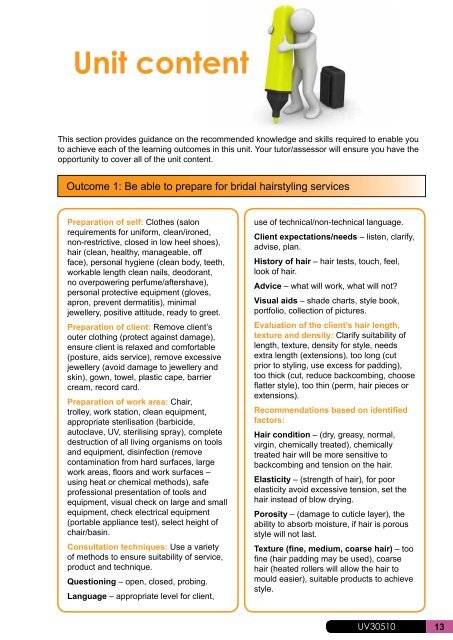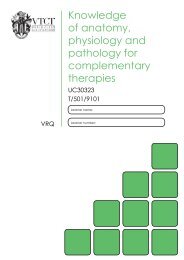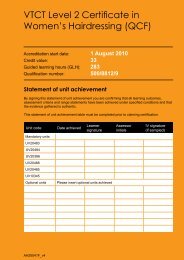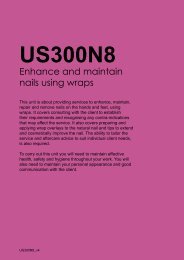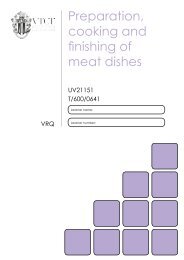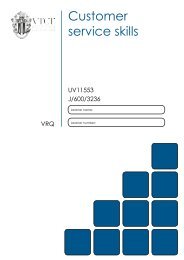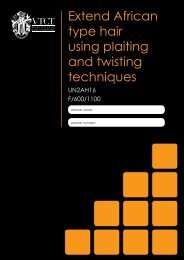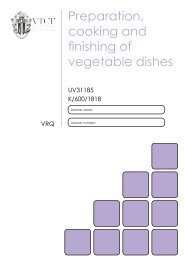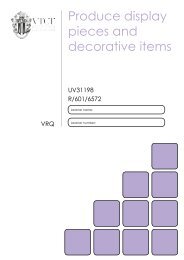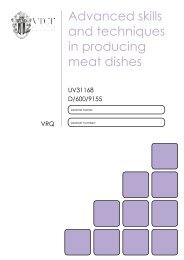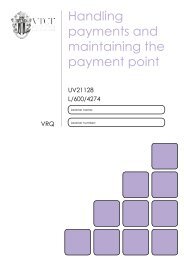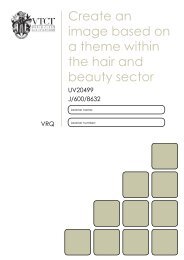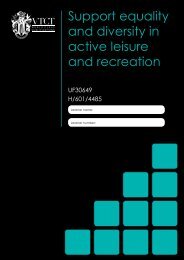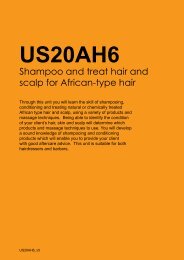UV30510 K/600/9059 - VTCT
UV30510 K/600/9059 - VTCT
UV30510 K/600/9059 - VTCT
You also want an ePaper? Increase the reach of your titles
YUMPU automatically turns print PDFs into web optimized ePapers that Google loves.
Unit content<br />
This section provides guidance on the recommended knowledge and skills required to enable you<br />
to achieve each of the learning outcomes in this unit. Your tutor/assessor will ensure you have the<br />
opportunity to cover all of the unit content.<br />
Outcome 1: Be able to prepare for bridal hairstyling services<br />
Preparation of self: Clothes (salon<br />
requirements for uniform, clean/ironed,<br />
non-restrictive, closed in low heel shoes),<br />
hair (clean, healthy, manageable, off<br />
face), personal hygiene (clean body, teeth,<br />
workable length clean nails, deodorant,<br />
no overpowering perfume/aftershave),<br />
personal protective equipment (gloves,<br />
apron, prevent dermatitis), minimal<br />
jewellery, positive attitude, ready to greet.<br />
Preparation of client: Remove client’s<br />
outer clothing (protect against damage),<br />
ensure client is relaxed and comfortable<br />
(posture, aids service), remove excessive<br />
jewellery (avoid damage to jewellery and<br />
skin), gown, towel, plastic cape, barrier<br />
cream, record card.<br />
Preparation of work area: Chair,<br />
trolley, work station, clean equipment,<br />
appropriate sterilisation (barbicide,<br />
autoclave, UV, sterilising spray), complete<br />
destruction of all living organisms on tools<br />
and equipment, disinfection (remove<br />
contamination from hard surfaces, large<br />
work areas, floors and work surfaces –<br />
using heat or chemical methods), safe<br />
professional presentation of tools and<br />
equipment, visual check on large and small<br />
equipment, check electrical equipment<br />
(portable appliance test), select height of<br />
chair/basin.<br />
Consultation techniques: Use a variety<br />
of methods to ensure suitability of service,<br />
product and technique.<br />
Questioning – open, closed, probing.<br />
Language – appropriate level for client,<br />
use of technical/non-technical language.<br />
Client expectations/needs – listen, clarify,<br />
advise, plan.<br />
History of hair – hair tests, touch, feel,<br />
look of hair.<br />
Advice – what will work, what will not?<br />
Visual aids – shade charts, style book,<br />
portfolio, collection of pictures.<br />
Evaluation of the client’s hair length,<br />
texture and density: Clarify suitability of<br />
length, texture, density for style, needs<br />
extra length (extensions), too long (cut<br />
prior to styling, use excess for padding),<br />
too thick (cut, reduce backcombing, choose<br />
flatter style), too thin (perm, hair pieces or<br />
extensions).<br />
Recommendations based on identified<br />
factors:<br />
Hair condition – (dry, greasy, normal,<br />
virgin, chemically treated), chemically<br />
treated hair will be more sensitive to<br />
backcombing and tension on the hair.<br />
Elasticity – (strength of hair), for poor<br />
elasticity avoid excessive tension, set the<br />
hair instead of blow drying.<br />
Porosity – (damage to cuticle layer), the<br />
ability to absorb moisture, if hair is porous<br />
style will not last.<br />
Texture (fine, medium, coarse hair) – too<br />
fine (hair padding may be used), coarse<br />
hair (heated rollers will allow the hair to<br />
mould easier), suitable products to achieve<br />
style.<br />
<strong>UV30510</strong> 13


